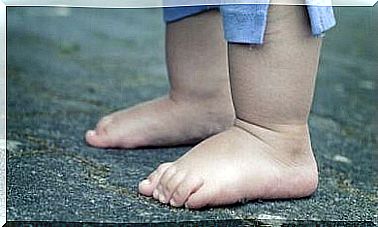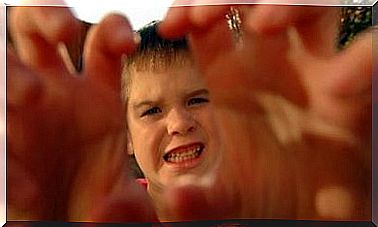Mononucleosis In Children

Mononucleosis in children, just like in adults, is an infectious disease, also known as the “kissing disease”. While this nickname may sound affectionate, its symptoms are far less so.
The age at which it is easiest to contract it is between 15 and 25 years. However, even young children can get it, because they are always exposed to kisses from adults.
It is very important that no one kisses our child on the mouth. Not even his parents have to do it, because the mouth is one of the points in our body where the greatest number of viruses and bacteria coexist and, as in the case of mononucleosis , it represents a path of contagion.
Causes of mononucleosis in children
Mononucleosis is an infection caused by the Epstein-Barr virus (EBV). It is not a disease with which one gets infected as easily as a cold. However, its symptoms affect the lymphatic ganglia, throat, salivary glands, liver and spleen. As you can see, this is not a nonsense to be underestimated, and we need to know the causes, to try to prevent contagion in our children.
Below we list the main forms of contagion through which your child can contract this virus:
- The infection occurs mainly through saliva. This is why it is so important that no one kisses our child’s mouth. Nor should we allow her to share kitchen cutlery, biting-and-mouth toys, and no oral hygiene utensils.
- Sharing pillows with an infected person can probably infect us.
- Exposing ourselves to coughing or sneezing from an infected person.
Main symptoms
To know what to do if you suspect the presence of this disease and to be able to identify it easily, it is important to know the symptoms it causes. Here are the main symptoms:
- Very high fever.
- Inflammation and sore throat.
- Increase in size and irritation of the neck ganglia.
- Muscle fatigue or muscle pain.
- Cough or mucus.
- Swelling in the eyelids.
- Increase in the size of the spleen (this can only be checked by the doctor).
- General malaise, headache, loss of appetite, etc.

Treatment of mononucleosis in children
The reality is that there is no real cure to treat mononucleosis. Antibiotics have no effect, since it is a disease transmitted by a virus.
It is a long-lasting disease. The virus begins to disappear on its own about four weeks after the first symptoms appear. It is recommended to try to alleviate these symptoms in order to improve the mood of the sick child.
We recommend that you:
- Keep the baby constantly hydrated, so that his throat stays cool.
- Help him and be responsible for his oral hygiene. It is recommended to gargle with salt water.
- If your doctor has decided that you should take ibuprofen, it is very important to stick to the prescribed doses and schedules.
- The child must stay relaxed and getting enough rest , so that his body can fight off the infection more effectively.
- Try to lower the child’s fever if it is present.
- Prevent your child from exercising excessively, especially to prevent tearing of the spleen if it has been inflamed by the virus.
- Due to the inflammation, the baby will have a hard time ingesting solid, hot food. You will need to replace them with soft foods, such as dairy products, lukewarm purees and creams, fruit juices, yogurt, etc.
- Keep your child away from places where smoke is present, which could irritate his throat even more.
- Disinfect pacifiers, toys, glasses, or anything that comes to your mouth often. The virus survives for several hours outside the body and, without these precautions, we could cause another contagion.

Duration
The duration of this disease will depend on the ability of each organism to oppose this virus. First, we must understand that this disease can be asymptomatic even 7 weeks after the infection has developed. As we can see, its incubation period is very long.
From the onset of the first symptoms, mononucleosis in children is estimated to last for two to four weeks on average . This is only a rough estimate, though.
What else do I need to know?
It is very rare for this disease to cause complications. Nonetheless, here are some of the symptoms that can signal them:
- Sharp pain in the left upper abdomen.
- Feeling confused or seasick.
- Blurred vision.
- Fainting.
Finally, it is important to know that the person infected with this virus will keep it inside their body for the rest of their life. Do not worry: this does not mean that the symptoms will be present throughout life, but only that the virus will continue to reside in the body, increasingly losing its effectiveness.
A person who has had mononucleosis does not have to worry all their life about avoiding infecting another person. However, it is important that you pay attention during the first year that you have contracted this disease.









